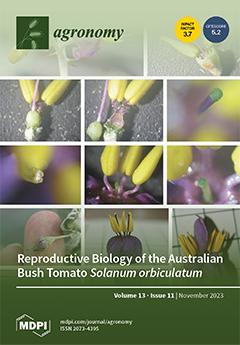With crop yields continually increasing, chemical fertilizer consumption in China is increasing in parallel. The excessive use of synthetic fertilizer can lead to soil compaction, acidification, and degeneration, which can all be mitigated through additional organic manure application. The combined application of organic manure and inorganic fertilizer plays crucial roles in the root morphology and yield formation of dryland crops. In this study, foxtail millet (Chang Sheng 07) was used as the experimental material and sown in a dry farming area with five different fertilizing patterns, which were composed of chemical N, P, organic manure, and microbial manure. These patterns included a single application of 45 kg·ha
−1 of nitrogen fertilizer as the control (N
45), the combined application of 60 kg·ha
−1 of nitrogen fertilizer with 30 kg·ha
−1 of phosphorus fertilizer (N
60P
30), the combined application of 90 kg·ha
−1 of nitrogen fertilizer with 45 kg·ha
−1 of phosphorus fertilizer (N
90P
45), 60 kg·ha
−1 of nitrogen fertilizer and 40 kg·ha
−1 of phosphorus fertilizer with 2000 kg·ha
−1 of organic manure (N
60P
40-O), and 60 kg·ha
−1 of nitrogen fertilizer and 40 kg·ha
−1 of phosphorus fertilizer with 5 kg·ha
−1 of microbial manure (N
60P
40-M). Each treatment was performed with four repeats. The results show that (1) the different fertilization patterns had significant effects on the morphological construction of foxtail millet roots, and the root length (
RL) with N
60P
40–O underwent a significant increase of 88.23% and 61.59% in the two stages, respectively, (2) as confirmed by the correlation analysis, the root surface area (
RSA) was positively correlated with the
RL and root volume (
RV), (3) the yields with N
90P
45 and N
60P
30 exhibited a significant increase of 54.43% and 59.86%, and those with N
60P
40–O and N
60P
40–M stably increased by 13.12–24.11% compared to those with N
45, and (4) the water use efficiency (
WUE) of foxtail millet under the N
60P
30 and N
90P
45 patterns significantly increased by 33.40–62.39%, while that under the N
60P
40–O and N
60P
40–M patterns increased by 12.89–29.20%. In summary, the application of additional organic matter and microbial manure promoted the morphological construction of foxtail millet roots, led to better stability in grain production, and is an ecofriendly option in terms of sustainable land use.
Full article





